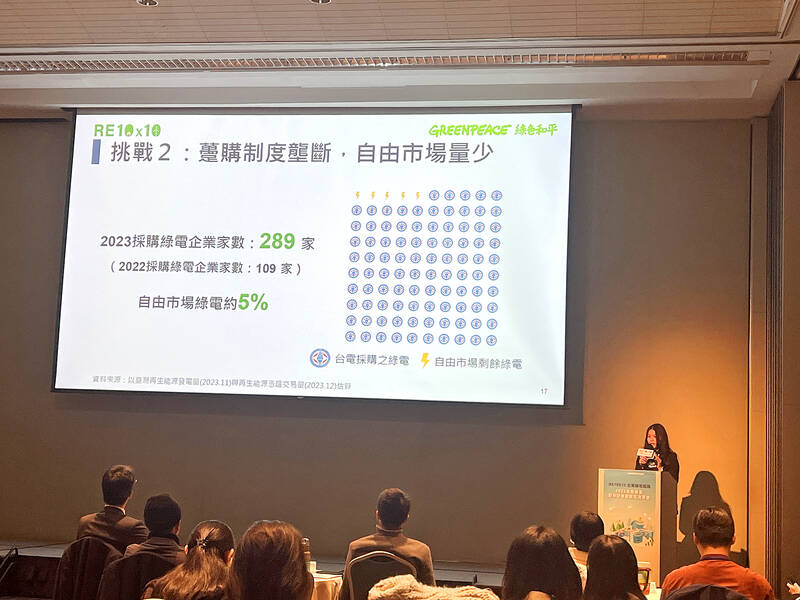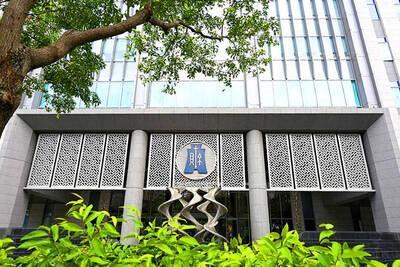Greenpeace on Tuesday called for the near monopolization of domestic renewable energy supply by Taiwan Power Co (Taipower) to be replaced by a framework that better supports the self-generation of green electricity by private enterprises.
Greenpeace made the recommendation in its annual report on RE10x10, an initiative launched by the non-governmental organization in 2020 advocating for Taiwanese enterprises to reach 10 percent green electricity use by 2025, and 100 percent by 2050.
Describing green electricity as in “dire short supply,” the report said that Taipower currently purchases about 95 percent of the renewable energy generated in Taiwan under its Feed-in-Tariff program, a long-term contract initially offered to renewable energy companies to insure them against market volatility.

Photo: Chen Chia-yi, Taipei Times
As of November last year, the total amount of renewable energy generated in the nation was 22.96 billion kilowatt-hours, but only 1.283 million T-Rec certificates — Taiwan’s renewable energy certificate — were issued, Greenpeace’s Lydia Fang (方君維) said.
A certificate is equivalent to 1,000 kilowatt-hours.
That means that only about 5 percent of the renewable energy generated was on the market for enterprises to purchase, Fang said, adding that about 80 percent of the remainder was purchased by Taiwan Semiconductor Manufacturing Co.
Fang said Greenpeace advises the government to help mediate between providers, electricity-intensive enterprises that are willing to set up green electricity facilities for their own use and those enterprises that have experience installing renewable energy facilities.
Green electricity can be obtained in three ways — direct supply from renewable energy-generating companies, having green energy generated by renewable energy companies via Taipower’s distribution system or T-Rec purchasing.
New ways have been developed throughout the renewable energy market, such as setting up green energy facilities such as solar panels or investing in facilities installed outside a company, such as a school, and purchasing the electricity generated, Fang said.
The government therefore has a role to play in offering a mediation platform to these parties — enterprises with green energy needs, renewable energy companies and those who have the space to facilitate production of green electricity needed by Taiwanese companies, Fang said.
There is a shortage of green energy supply in Taiwan rendering it extremely difficult for enterprises to obtain green electricity, Fang said.
The report says that 18 of the 102 companies that have signed up to the RE10x10 pledge had successfully reached 10 percent green electricity use, with 11 surpassing 20 percent.

A group of Taiwanese-American and Tibetan-American students at Harvard University on Saturday disrupted Chinese Ambassador to the US Xie Feng’s (謝鋒) speech at the school, accusing him of being responsible for numerous human rights violations. Four students — two Taiwanese Americans and two from Tibet — held up banners inside a conference hall where Xie was delivering a speech at the opening ceremony of the Harvard Kennedy School China Conference 2024. In a video clip provided by the Coalition of Students Resisting the CCP (Chinese Communist Party), Taiwanese-American Cosette Wu (吳亭樺) and Tibetan-American Tsering Yangchen are seen holding banners that together read:

UNAWARE: Many people sit for long hours every day and eat unhealthy foods, putting them at greater risk of developing one of the ‘three highs,’ an expert said More than 30 percent of adults aged 40 or older who underwent a government-funded health exam were unaware they had at least one of the “three highs” — high blood pressure, high blood lipids or high blood sugar, the Health Promotion Administration (HPA) said yesterday. Among adults aged 40 or older who said they did not have any of the “three highs” before taking the health exam, more than 30 percent were found to have at least one of them, Adult Preventive Health Examination Service data from 2022 showed. People with long-term medical conditions such as hypertension or diabetes usually do not

POLICE INVESTIGATING: A man said he quit his job as a nurse at Taipei Tzu Chi Hospital as he had been ‘disgusted’ by the behavior of his colleagues A man yesterday morning wrote online that he had witnessed nurses taking photographs and touching anesthetized patients inappropriately in Taipei Tzu Chi Hospital’s operating theaters. The man surnamed Huang (黃) wrote on the Professional Technology Temple bulletin board that during his six-month stint as a nurse at the hospital, he had seen nurses taking pictures of patients, including of their private parts, after they were anesthetized. Some nurses had also touched patients inappropriately and children were among those photographed, he said. Huang said this “disgusted” him “so much” that “he felt the need to reveal these unethical acts in the operating theater

COGNITIVE WARFARE: Allegations that the documents were proof that the former US envoy tried to smuggle alcohol were designed to manipulate public opinion Leaked documents related to customs clearance procedures for vice president-elect Hsiao Bi-khim (蕭美琴) that have been circulating on the Internet appear to be an attempt to manipulate public opinion against the government, a source said on Sunday. A post on online platform Baoliao Commune (爆料公社) on Sunday showed documents it said were evidence that Hsiao had smuggled alcohol through customs with the assistance of the Ministry of Foreign Affairs, and said that the documents were part of a 4GB data dump of confidential material acquired by hackers. In a rebuttal, the source said that they were not confidential documents, but rather